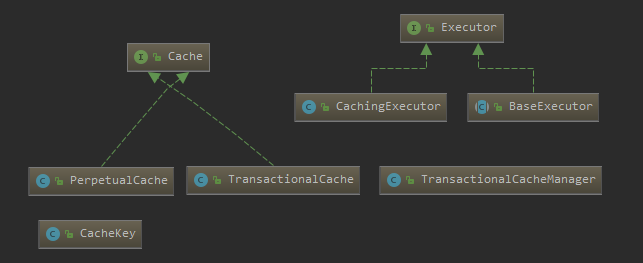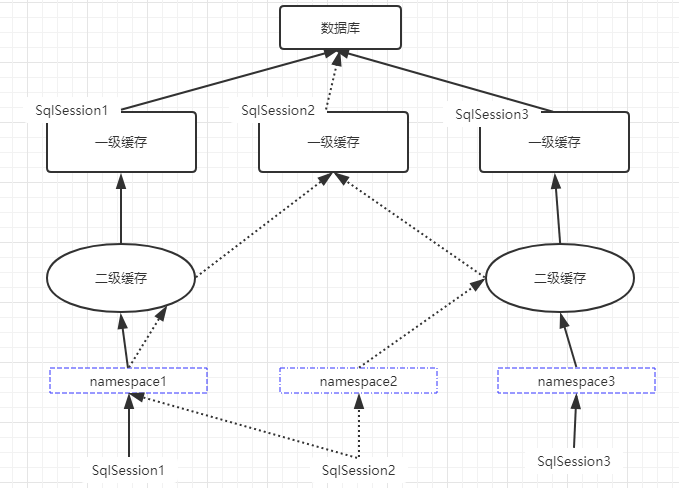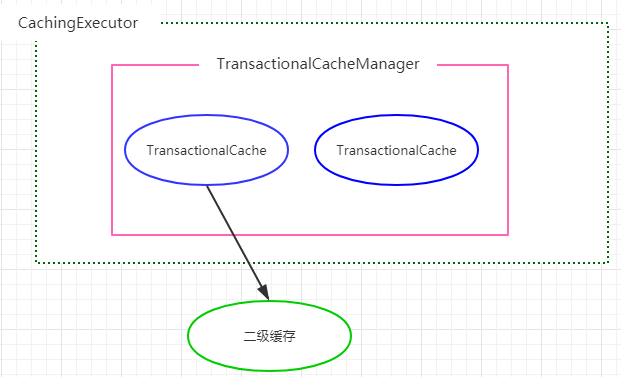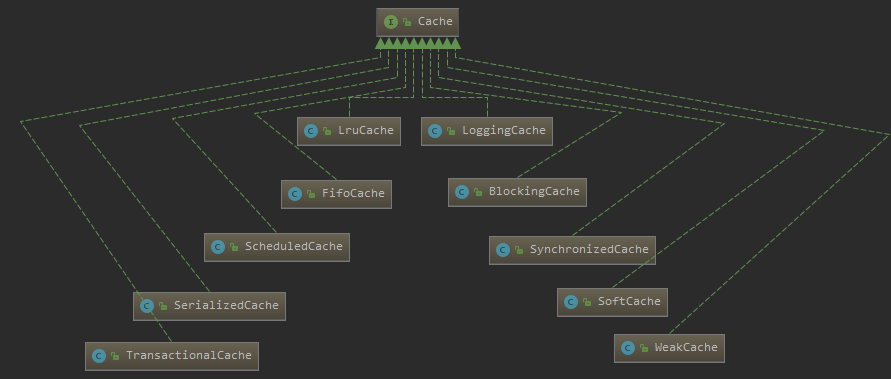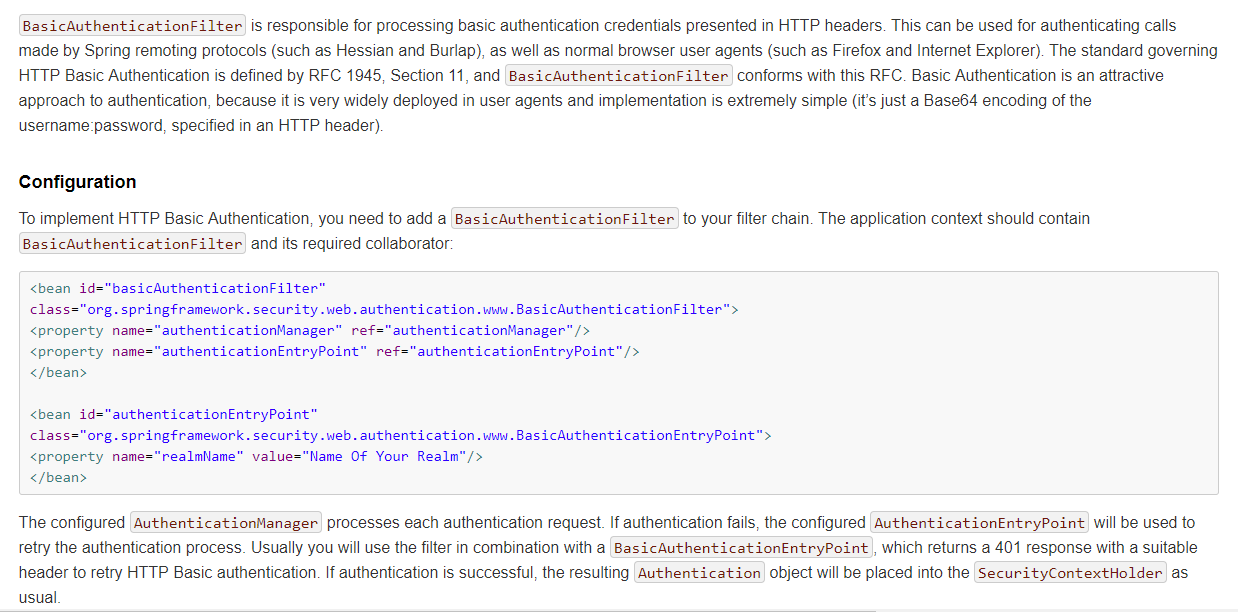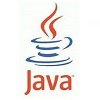Mybatis 缓存系统源码解析
本文从以下几个方面介绍:
相关文章
前言
缓存的相关接口
一级缓存的实现过程
二级缓存的实现过程
如何保证缓存的线程安全
缓存的装饰器
相关文章
Mybatis Mapper.xml 配置文件中 resultMap 节点的源码解析
Mybatis Mapper 接口源码解析(binding包)
Mybatis 数据源和数据库连接池源码解析(DataSource)
前言
在使用诸如 Mybatis 这种 ORM 框架的时候,一般都会提供缓存功能,用来缓存从数据库查询到的结果,当下一次查询条件相同的时候,只需从缓存中进行查找返回即可,如果缓存中没有,再去查库;一方面是提高查询速度,另一方面是减少数据库压力;Mybatis 也提供了缓存,它分为一级缓存和二级缓存,接下来就来看看它的缓存系统是如何实现的。
缓存系统的实现使用了 模板方法模式 和 装饰器模式
接下来先来看下和缓存相关的接口
Cache
Mybatis 使用 Cache 来表示缓存,它是一个接口,定义了缓存需要的一些方法,如下所示:
public interface Cache {
//获取缓存的id,即 namespace
String getId();
// 添加缓存
void putObject(Object key, Object value);
//根据key来获取缓存对应的值
Object getObject(Object key);
// 删除key对应的缓存
Object removeObject(Object key);
// 清空缓存
void clear();
// 获取缓存中数据的大小
int getSize();
//取得读写锁, 从3.2.6开始没用了
ReadWriteLock getReadWriteLock();
}对于每一个 namespace 都会创建一个缓存的实例,Cache 实现类的构造方法都必须传入一个 String 类型的ID,Mybatis自身的实现类都使用 namespace 作为 ID
PerpetualCache
Mybatis 为 Cache 接口提供的唯一一个实现类就是 PerpetualCache,这个唯一并不是说 Cache 只有一个实现类,只是缓存的处理逻辑,Cache 还有其他的实现类,但是只是作为装饰器存在,只是对 Cache 进行包装而已。
PerpetualCache 的实现比较简单,就是把对应的 key-value 缓存数据存入到 map 中,如下所示:
public class PerpetualCache implements Cache {
// id,一般对应mapper.xml 的namespace 的值
private String id;
// 用来存放数据,即缓存底层就是使用 map 来实现的
private Map<Object, Object> cache = new HashMap<Object, Object>();
public PerpetualCache(String id) {
this.id = id;
}
//......其他的getter方法.....
// 添加缓存
@Override
public void putObject(Object key, Object value) {
cache.put(key, value);
}
// 获取缓存
@Override
public Object getObject(Object key) {
return cache.get(key);
}
// 删除缓存
@Override
public Object removeObject(Object key) {
return cache.remove(key);
}
// 清空缓存
@Override
public void clear() {
cache.clear();
}
}从上面的代码逻辑可以看到,mybatis 提供的缓存底层就是使用一个 HashMap 来实现的,但是我们知道,HashMap 不是线程安全的,它是如何来保证缓存中的线程安全问题呢?在后面讲到 Cache 的包装类就知道,它提供了一个 SynchronizedCache 的装饰器类,就是用来包装线程安全的,在该类中所有方法都加上了 synchronized 关键字。
CacheKey
Mybatis 的缓存使用了 key-value 的形式存入到 HashMap 中,而 key 的话,Mybatis 使用了 CacheKey 来表示 key,它的生成规则为:mappedStementId + offset + limit + SQL + queryParams + environment生成一个哈希码.
public class CacheKey implements Cloneable, Serializable {
private static final int DEFAULT_MULTIPLYER = 37;
private static final int DEFAULT_HASHCODE = 17;
// 参与计算hashcode,默认值为37
private int multiplier;
// CacheKey 对象的 hashcode ,默认值 17
private int hashcode;
// 检验和
private long checksum;
// updateList 集合的个数
private int count;
// 由该集合中的所有对象来共同决定两个 CacheKey 是否相等
private List<Object> updateList;
public int getUpdateCount() {
return updateList.size();
}
// 调用该方法,向 updateList 集合添加对应的对象
public void update(Object object) {
if (object != null && object.getClass().isArray()) {
// 如果是数组,则循环处理每一项
int length = Array.getLength(object);
for (int i = 0; i < length; i++) {
Object element = Array.get(object, i);
doUpdate(element);
}
} else {
doUpdate(object);
}
}
// 计算 count checksum hashcode 和把对象添加到 updateList 集合中
private void doUpdate(Object object) {
int baseHashCode = object == null ? 1 : object.hashCode();
count++;
checksum += baseHashCode;
baseHashCode *= count;
hashcode = multiplier * hashcode + baseHashCode;
updateList.add(object);
}
// 判断两个 CacheKey 是否相等
@Override
public boolean equals(Object object) {
if (this == object) {
return true;
}
if (!(object instanceof CacheKey)) {
return false;
}
final CacheKey cacheKey = (CacheKey) object;
if (hashcode != cacheKey.hashcode) {
return false;
}
if (checksum != cacheKey.checksum) {
return false;
}
if (count != cacheKey.count) {
return false;
}
// 如果前几项都不满足,则循环遍历 updateList 集合,判断每一项是否相等,如果有一项不相等则这两个CacheKey不相等
for (int i = 0; i < updateList.size(); i++) {
Object thisObject = updateList.get(i);
Object thatObject = cacheKey.updateList.get(i);
if (thisObject == null) {
if (thatObject != null) {
return false;
}
} else {
if (!thisObject.equals(thatObject)) {
return false;
}
}
}
return true;
}
@Override
public int hashCode() {
return hashcode;
}
}
如果需要进行缓存,则如何创建 CacheKey 呢?下面这个就是创建 一个 CacheKey 的方法:
public CacheKey createCacheKey(MappedStatement ms, Object parameterObject, RowBounds rowBounds, BoundSql boundSql) {
//cacheKey 对象
CacheKey cacheKey = new CacheKey();
// 向 updateList 存入id
cacheKey.update(ms.getId());
// 存入offset
cacheKey.update(rowBounds.getOffset());
// 存入limit
cacheKey.update(rowBounds.getLimit());
// 存入sql
cacheKey.update(boundSql.getSql());
List<ParameterMapping> parameterMappings = boundSql.getParameterMappings();
TypeHandlerRegistry typeHandlerRegistry = ms.getConfiguration().getTypeHandlerRegistry();
for (ParameterMapping parameterMapping : parameterMappings) {
if (parameterMapping.getMode() != ParameterMode.OUT) {
String propertyName = parameterMapping.getProperty();
MetaObject metaObject = configuration.newMetaObject(parameterObject);
Object value = metaObject.getValue(propertyName);
// 存入每一个参数
cacheKey.update(value);
}
}
if (configuration.getEnvironment() != null) {
// 存入 environmentId
cacheKey.update(configuration.getEnvironment().getId());
}
return cacheKey;
}从上面 CacheKey 和创建 CacheKey 的代码逻辑可以看出,Mybatis 的缓存使用了 mappedStementId + offset + limit + SQL + queryParams + environment 生成的hashcode作为 key。
了解了上述和缓存相关的接口后,接下来就来看看 Mybatis 的缓存系统是如何实现的,Mybatis 的缓存分为一级缓存和二级缓存,一级缓存是在 BaseExecutor 中实现的,二级缓存是在 CachingExecutor 中实现的。
Executor
Executor 接口定义了操作数据库的基本方法,SqlSession 的相关方法就是基于 Executor 接口实现的,它定义了操作数据库的方法如下:
public interface Executor {
ResultHandler NO_RESULT_HANDLER = null;
// insert | update | delete 的操作方法
int update(MappedStatement ms, Object parameter) throws SQLException;
// 查询,带分页,带缓存
<E> List<E> query(MappedStatement ms, Object parameter, RowBounds rowBounds, ResultHandler resultHandler, CacheKey cacheKey, BoundSql boundSql) throws SQLException;
// 查询,带分页
<E> List<E> query(MappedStatement ms, Object parameter, RowBounds rowBounds, ResultHandler resultHandler) throws SQLException;
// 查询存储过程
<E> Cursor<E> queryCursor(MappedStatement ms, Object parameter, RowBounds rowBounds) throws SQLException;
//刷新批处理语句
List<BatchResult> flushStatements() throws SQLException;
// 事务提交
void commit(boolean required) throws SQLException;
// 事务回滚
void rollback(boolean required) throws SQLException;
// 创建缓存的key
CacheKey createCacheKey(MappedStatement ms, Object parameterObject, RowBounds rowBounds, BoundSql boundSql);
// 是否缓存
boolean isCached(MappedStatement ms, CacheKey key);
// 清空缓存
void clearLocalCache();
// 延迟加载
void deferLoad(MappedStatement ms, MetaObject resultObject, String property, CacheKey key, Class<?> targetType);
// 获取事务
Transaction getTransaction();
}一级缓存
BaseExecutor
BaseExecutor 是一个抽象类,实现了 Executor 接口,并提供了大部分方法的实现,只有 4 个基本方法:doUpdate, doQuery, doQueryCursor, doFlushStatement 没有实现,还是一个抽象方法,由子类实现,这 4 个方法相当于模板方法中变化的那部分。
Mybatis 的一级缓存就是在该类中实现的。
Mybatis 的一级缓存是会话级别的缓存,Mybatis 每创建一个 SqlSession 对象,就表示打开一次数据库会话,在一次会话中,应用程序很可能在短时间内反复执行相同的查询语句,如果不对数据进行缓存,则每查询一次就要执行一次数据库查询,这就造成数据库资源的浪费。又因为通过 SqlSession 执行的操作,实际上由 Executor 来完成数据库操作的,所以在 Executor 中会建立一个简单的缓存,即一级缓存;将每次的查询结果缓存起来,再次执行查询的时候,会先查询一级缓存,如果命中,则直接返回,否则再去查询数据库并放入缓存中。
一级缓存的生命周期与 SqlSession 的生命周期相同,当调用 Executor.close 方法的时候,缓存变得不可用。一级缓存是默认开启的,一般情况下不需要特殊的配置,如果需要特殊配置,则可以通过插件的形式来实现
public abstract class BaseExecutor implements Executor {
// 事务,提交,回滚,关闭事务
protected Transaction transaction;
// 底层的 Executor 对象
protected Executor wrapper;
// 延迟加载队列
protected ConcurrentLinkedQueue<DeferredLoad> deferredLoads;
// 一级缓存,用于缓存查询结果
protected PerpetualCache localCache;
// 一级缓存,用于缓存输出类型参数(存储过程)
protected PerpetualCache localOutputParameterCache;
protected Configuration configuration;
// 用来记录嵌套查询的层数
protected int queryStack;
private boolean closed;
protected BaseExecutor(Configuration configuration, Transaction transaction) {
this.transaction = transaction;
this.deferredLoads = new ConcurrentLinkedQueue<DeferredLoad>();
this.localCache = new PerpetualCache("LocalCache");
this.localOutputParameterCache = new PerpetualCache("LocalOutputParameterCache");
this.closed = false;
this.configuration = configuration;
this.wrapper = this;
}
// 4 个抽象方法,由子类实现,模板方法中可变部分
protected abstract int doUpdate(MappedStatement ms, Object parameter)throws SQLException;
protected abstract List<BatchResult> doFlushStatements(boolean isRollback) throws SQLException;
protected abstract <E> List<E> doQuery(MappedStatement ms, Object parameter, RowBounds rowBounds, ResultHandler resultHandler, BoundSql boundSql)throws SQLException;
protected abstract <E> Cursor<E> doQueryCursor(MappedStatement ms, Object parameter, RowBounds rowBounds, BoundSql boundSql)throws SQLException;
// 执行 insert | update | delete 语句,调用 doUpdate 方法实现,在执行这些语句的时候,会清空缓存
public int update(MappedStatement ms, Object parameter) throws SQLException {
// ....
// 清空缓存
clearLocalCache();
// 执行SQL语句
return doUpdate(ms, parameter);
}
// 刷新批处理语句,且执行缓存中还没执行的SQL语句
@Override
public List<BatchResult> flushStatements() throws SQLException {
return flushStatements(false);
}
public List<BatchResult> flushStatements(boolean isRollBack) throws SQLException {
// ...
// doFlushStatements 的 isRollBack 参数表示是否执行缓存中的SQL语句,false表示执行,true表示不执行
return doFlushStatements(isRollBack);
}
// 查询存储过程
@Override
public <E> Cursor<E> queryCursor(MappedStatement ms, Object parameter, RowBounds rowBounds) throws SQLException {
BoundSql boundSql = ms.getBoundSql(parameter);
return doQueryCursor(ms, parameter, rowBounds, boundSql);
}
// 事务的提交和回滚
@Override
public void commit(boolean required) throws SQLException {
// 清空缓存
clearLocalCache();
// 刷新批处理语句,且执行缓存中的QL语句
flushStatements();
if (required) {
transaction.commit();
}
}
@Override
public void rollback(boolean required) throws SQLException {
if (!closed) {
try {
// 清空缓存
clearLocalCache();
// 刷新批处理语句,且不执行缓存中的SQL
flushStatements(true);
} finally {
if (required) {
transaction.rollback();
}
}
}
}在上面的代码逻辑中,执行update类型的语句会清空缓存,且执行结果不需要进行缓存,而在执行查询语句的时候,需要对数据进行缓存,如下所示:
@Override
public <E> List<E> query(MappedStatement ms, Object parameter, RowBounds rowBounds, ResultHandler resultHandler) throws SQLException {
// 获取查询SQL
BoundSql boundSql = ms.getBoundSql(parameter);
// 创建缓存的key,创建逻辑在 CacheKey中已经分析过了
CacheKey key = createCacheKey(ms, parameter, rowBounds, boundSql);
// 执行查询
return query(ms, parameter, rowBounds, resultHandler, key, boundSql);
}
// 执行查询逻辑
public <E> List<E> query(MappedStatement ms, Object parameter, RowBounds rowBounds, ResultHandler resultHandler, CacheKey key, BoundSql boundSql) throws SQLException {
// ....
if (queryStack == 0 && ms.isFlushCacheRequired()) {
// 如果不是嵌套查询,且 <select> 的 flushCache=true 时才会清空缓存
clearLocalCache();
}
List<E> list;
try {
// 嵌套查询层数加1
queryStack++;
// 首先从一级缓存中进行查询
list = resultHandler == null ? (List<E>) localCache.getObject(key) : null;
if (list != null) {
// 如果命中缓存,则处理存储过程
handleLocallyCachedOutputParameters(ms, key, parameter, boundSql);
} else {
// 如果缓存中没有对应的数据,则查数据库中查询数据
list = queryFromDatabase(ms, parameter, rowBounds, resultHandler, key, boundSql);
}
} finally {
queryStack--;
}
// ... 处理延迟加载的相关逻辑
return list;
}
// 从数据库查询数据
private <E> List<E> queryFromDatabase(MappedStatement ms, Object parameter, RowBounds rowBounds, ResultHandler resultHandler, CacheKey key, BoundSql boundSql) throws SQLException {
List<E> list;
// 在缓存中添加占位符
localCache.putObject(key, EXECUTION_PLACEHOLDER);
try {
// 查库操作,由子类实现
list = doQuery(ms, parameter, rowBounds, resultHandler, boundSql);
} finally {
// 删除占位符
localCache.removeObject(key);
}
// 将从数据库查询的结果添加到一级缓存中
localCache.putObject(key, list);
// 处理存储过程
if (ms.getStatementType() == StatementType.CALLABLE) {
localOutputParameterCache.putObject(key, parameter);
}
return list;
}二级缓存
Mybatis 提供的二级缓存是应用级别的缓存,它的生命周期和应用程序的生命周期相同,且与二级缓存相关的配置有以下 3 个:
1. mybatis-config.xml 配置文件中的 cacheEnabled 配置,它是二级缓存的总开关,只有该配置为 true ,后面的缓存配置才会生效。默认为 true,即二级缓存默认是开启的。
2. Mapper.xml 配置文件中配置的 <cache> 和 <cache-ref>标签,如果 Mapper.xml 配置文件中配置了这两个标签中的任何一个,则表示开启了二级缓存的功能,在 Mybatis 解析 SQL 源码分析一 文章中已经分析过,如果配置了 <cache> 标签,则在解析配置文件的时候,会为该配置文件指定的 namespace 创建相应的 Cache 对象作为其二级缓存(默认为 PerpetualCache 对象),如果配置了 <cache-ref> 节点,则通过 ref 属性的namespace值引用别的Cache对象作为其二级缓存。通过 <cache> 和 <cache-ref> 标签来管理其在namespace中二级缓存功能的开启和关闭
3. <select> 节点中的 useCache 属性也可以开启二级缓存,该属性表示查询的结果是否要存入到二级缓存中,该属性默认为 true,也就是说 <select> 标签默认会把查询结果放入到二级缓存中。
Mybatis 的二级缓存是用 CachingExecutor 来实现的,它是 Executor 的一个装饰器类。为 Executor 对象添加了缓存的功能。
在介绍 CachingExecutor 之前,先来看看 CachingExecutor 依赖的两个类,TransactionalCacheManager 和 TransactionalCache。
TransactionalCache
TransactionalCache 实现了 Cache 接口,主要用于保存在某个 SqlSession 的某个事务中需要向某个二级缓存中添加的数据,代码如下:
public class TransactionalCache implements Cache {
// 底层封装的二级缓存对应的Cache对象
private Cache delegate;
// 为true时,表示当前的 TransactionalCache 不可查询,且提交事务时会清空缓存
private boolean clearOnCommit;
// 存放需要添加到二级缓存中的数据
private Map<Object, Object> entriesToAddOnCommit;
// 存放为命中缓存的 CacheKey 对象
private Set<Object> entriesMissedInCache;
public TransactionalCache(Cache delegate) {
this.delegate = delegate;
this.clearOnCommit = false;
this.entriesToAddOnCommit = new HashMap<Object, Object>();
this.entriesMissedInCache = new HashSet<Object>();
}
// 添加缓存数据的时候,先暂时放到 entriesToAddOnCommit 集合中,在事务提交的时候,再把数据放入到二级缓存中,避免脏数据
@Override
public void putObject(Object key, Object object) {
entriesToAddOnCommit.put(key, object);
}
// 提交事务,
public void commit() {
if (clearOnCommit) {
delegate.clear();
}
// 把 entriesToAddOnCommit 集合中的数据放入到二级缓存中
flushPendingEntries();
reset();
}
// 把 entriesToAddOnCommit 集合中的数据放入到二级缓存中
private void flushPendingEntries() {
for (Map.Entry<Object, Object> entry : entriesToAddOnCommit.entrySet()) {
// 放入到二级缓存中
delegate.putObject(entry.getKey(), entry.getValue());
}
for (Object entry : entriesMissedInCache) {
if (!entriesToAddOnCommit.containsKey(entry)) {
delegate.putObject(entry, null);
}
}
}
// 事务回滚
public void rollback() {
// 把未命中缓存的数据清除掉
unlockMissedEntries();
reset();
}
private void unlockMissedEntries() {
for (Object entry : entriesMissedInCache) {
delegate.removeObject(entry);
}
}TransactionalCacheManager
TransactionalCacheManager 用于管理 CachingExecutor 使用的二级缓存:
public class TransactionalCacheManager {
//用来管理 CachingExecutor 使用的二级缓存
// key 为对应的CachingExecutor 使用的二级缓存
// value 为对应的 TransactionalCache 对象
private Map<Cache, TransactionalCache> transactionalCaches = new HashMap<Cache, TransactionalCache>();
public void clear(Cache cache) {
getTransactionalCache(cache).clear();
}
public Object getObject(Cache cache, CacheKey key) {
return getTransactionalCache(cache).getObject(key);
}
public void putObject(Cache cache, CacheKey key, Object value) {
getTransactionalCache(cache).putObject(key, value);
}
public void commit() {
for (TransactionalCache txCache : transactionalCaches.values()) {
txCache.commit();
}
}
public void rollback() {
for (TransactionalCache txCache : transactionalCaches.values()) {
txCache.rollback();
}
}
// 所有的调用都会调用 TransactionalCache 的方法来实现
private TransactionalCache getTransactionalCache(Cache cache) {
TransactionalCache txCache = transactionalCaches.get(cache);
if (txCache == null) {
txCache = new TransactionalCache(cache);
transactionalCaches.put(cache, txCache);
}
return txCache;
}
}CachingExecutor
接下来看下 二级缓存的实现 CachingExecutor :
public class CachingExecutor implements Executor {
// 底层的 Executor
private Executor delegate;
private TransactionalCacheManager tcm = new TransactionalCacheManager();
// 查询方法
@Override
public <E> List<E> query(MappedStatement ms, Object parameterObject, RowBounds rowBounds, ResultHandler resultHandler) throws SQLException {
// 获取 SQL
BoundSql boundSql = ms.getBoundSql(parameterObject);
// 创建缓存key,在CacheKey中已经分析过创建过程
CacheKey key = createCacheKey(ms, parameterObject, rowBounds, boundSql);
return query(ms, parameterObject, rowBounds, resultHandler, key, boundSql);
}
// 查询
public <E> List<E> query(MappedStatement ms, Object parameterObject, RowBounds rowBounds, ResultHandler resultHandler, CacheKey key, BoundSql boundSql)
throws SQLException {
// 获取查询语句所在namespace对应的二级缓存
Cache cache = ms.getCache();
// 是否开启了二级缓存
if (cache != null) {
// 根据 <select> 的属性 useCache 的配置,决定是否需要清空二级缓存
flushCacheIfRequired(ms);
if (ms.isUseCache() && resultHandler == null) {
// 二级缓存不能保存输出参数,否则抛异常
ensureNoOutParams(ms, parameterObject, boundSql);
// 从二级缓存中查询对应的值
List<E> list = (List<E>) tcm.getObject(cache, key);
if (list == null) {
// 如果二级缓存没有命中,则调用底层的 Executor 查询,其中会先查询一级缓存,一级缓存也未命中,才会去查询数据库
list = delegate.<E> query(ms, parameterObject, rowBounds, resultHandler, key, boundSql);
// 查询到的数据放入到二级缓存中去
tcm.putObject(cache, key, list); // issue #578 and #116
}
return list;
}
}
// 如果没有开启二级缓存,则直接调用底层的 Executor 查询,还是会先查一级缓存
return delegate.<E> query(ms, parameterObject, rowBounds, resultHandler, key, boundSql);
}以上就是 Mybatis 的二级缓存的主要实现过程,CachingExecutor , TransactionalCacheManager 和 TransactionalCache 的关系如下所示,主要是通过 TransactionalCache 来操作二级缓存的。
此外,CachingExecutor 还有其他的一些方法,主要是调用底层封装的 Executor 来实现的。
以上就是 Mybatis 的一级缓存和二级缓存的实现过程。
Cache 装饰器
在介绍 Cache 接口的时候,说到,Cache 接口由很多的装饰器类,共 10 个,添加了不同的功能,如下所示:
来看看 SynchronizedCache 装饰器类吧,在上面的缓存实现中介绍到了 Mybatis 其实就是使用 HashMap 来实现缓存的,即把数据放入到 HashMap中,但是 HashMap 不是线安全的,Mybatis 是如何来保证缓存中的线程安全问题呢?就是使用了 SynchronizedCache 来保证的,它是一个装饰器类,其中的方法都加上了 synchronized 关键字:
public class SynchronizedCache implements Cache {
private Cache delegate;
public SynchronizedCache(Cache delegate) {
this.delegate = delegate;
}
@Override
public synchronized int getSize() {
return delegate.getSize();
}
@Override
public synchronized void putObject(Object key, Object object) {
delegate.putObject(key, object);
}
@Override
public synchronized Object getObject(Object key) {
return delegate.getObject(key);
}
@Override
public synchronized Object removeObject(Object key) {
return delegate.removeObject(key);
}
// ............
}接下来看下添加 Cache 装饰器的方法,在 CacheBuilder.build() 方法中进行添加:
public class CacheBuilder {
//...........
// 创建缓存
public Cache build() {
// 设置缓存的实现类
setDefaultImplementations();
Cache cache = newBaseCacheInstance(implementation, id);
setCacheProperties(cache);
// 添加装饰器类
if (PerpetualCache.class.equals(cache.getClass())) {
for (Class<? extends Cache> decorator : decorators) {
cache = newCacheDecoratorInstance(decorator, cache);
setCacheProperties(cache);
}
// 为 Cache 添加装饰器
cache = setStandardDecorators(cache);
} else if (!LoggingCache.class.isAssignableFrom(cache.getClass())) {
cache = new LoggingCache(cache);
}
return cache;
}
// 设置 Cache 的默认实现类为 PerpetualCache
private void setDefaultImplementations() {
if (implementation == null) {
implementation = PerpetualCache.class;
if (decorators.isEmpty()) {
decorators.add(LruCache.class);
}
}
}
// 添加装饰器
private Cache setStandardDecorators(Cache cache) {
try {
// 添加 ScheduledCache 装饰器
if (clearInterval != null) {
cache = new ScheduledCache(cache);
((ScheduledCache) cache).setClearInterval(clearInterval);
}
// 添加SerializedCache装饰器
if (readWrite) {
cache = new SerializedCache(cache);
}
// 添加 LoggingCache 装饰器
cache = new LoggingCache(cache);
// 添加 SynchronizedCache 装饰器,保证线程安全
cache = new SynchronizedCache(cache);
if (blocking) {
// 添加 BlockingCache 装饰器
cache = new BlockingCache(cache);
}
return cache;
}
}还有其他的装饰器,这里就不一一列出来了。
到这里 Mybatis 的缓存系统模块就分析完毕了。
